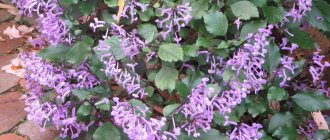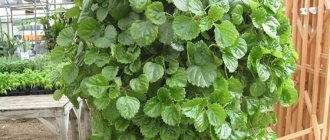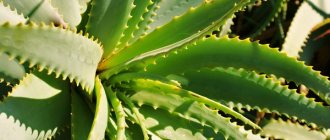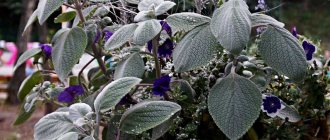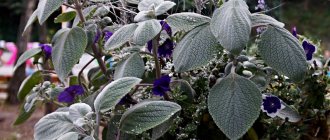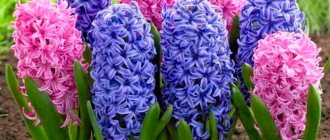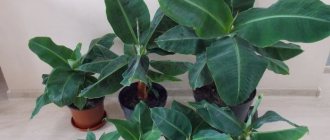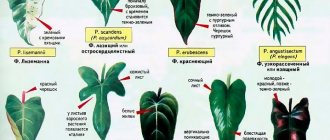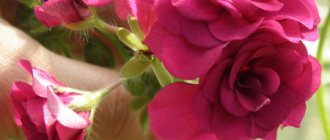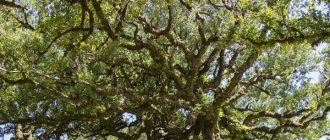Author: Elena N. https://floristics.info/ru/index.php?option=com_contact&view=contact&id=19 Category: Houseplants Published: January 29, 2018Last edits: January 11, 2021
- Plectranthus coleoides
- Beneficial features
- Is it possible to keep plectranthus at home?
Spurflower, or plectranthus (lat. Plectranthus) is a genus of the family Lamiaceae, or Lamiaceae, which, according to various sources, includes from 250 to 325 species. The Latin name of the genus is derived from the Greek words meaning “cockspur” and “flower”, hence the second name - spur flower. In nature, plectranthus are distributed in the subtropics and tropics of the Southern Hemisphere: in Madagascar, some Pacific islands, Australia, Indonesia and in areas adjacent to the Sahara. Plectranthus are used as medicinal, ornamental and aromatic plants, and their leaves are a food spice. Some representatives of the genus Spurflower are grown indoors.
Botanical description
Plectranthus (lat. Plectranthus) is a subtropical decorative deciduous semi-succulent plant.
The genus belongs to the Lamiaceae family, there are about 400 species in total.
It is characterized by:
- Height - from 15 to 100 cm.
- The stems are deep green or brownish-red in color, tetrahedral thin, often bare or covered with hairs, erect or creeping.
- The leaves are thick, fluffy with a strong scent, up to 10 cm in length. Rounded, heart-shaped, triangular with jagged edges, arranged crosswise.
- The root system is fibrous and goes shallow into the ground.
- Flowers are miniature bell-shaped buds of pink, white, lilac or violet, consisting of 5 petals fused at the base. They are located in racemose or umbrella-shaped inflorescences of 6-10 pieces each. After pollination, fruits with 4 nuts are formed.
You can learn about all types of mint here.
Useful properties and contraindications
The plant releases phytoncides that have an impact on the environment. Beneficial properties include:
- Improves the health of the air in the house by killing pathogenic bacteria.
- Repels moths, flies, mosquitoes and other insects.
- Has a medicinal effect.
- Increases a person’s well-being - considered another version of the “money tree”.
Plectranthus has contraindications:
- It is not recommended to take tea and its products for pregnant and lactating women and children under 12 years of age.
- May cause irritation to people with sensitive skin.
- May cause harm to hypotensive patients and people with varicose veins.
You can learn more about the benefits and harms of mint from this article.
Smell and taste
Plectranthus is a spicy-aromatic plant. Its leaves smell of camphor, lungwort and menthol notes with a mint aroma.
Plectranthus is aromatic in taste and smell, reminiscent of oregano and thyme and has a pleasant lemon-mint scent.
Decorative flower varieties: names and photos
Plectranthus is represented by numerous plant varieties. The most popular among them are several varieties.
Fragrant
Aromatic or fragrant plectranthus (lat. Plectranthus amboinicus) - can reach a height of 2 m. The stems are greenish-purple in color, the leaf plates are heart-shaped or round in shape with a blunt apex. Petioles with pubescence, flowers of a pale blue hue. It is this variety that is used to prepare decoctions and teas.
coleus-shaped
Plectranthus coleoides (lat. Plectranthus coleoides) - reaches a height of 1 m. The shoots are straight, tetrahedral with pubescence. The leaves are fleecy up to 8 cm with a crenate edge and a white border. The flowers are white.
Shrub or moth tree
Plectranthus fruticosus is a branched shrub. The height of the plant is about 100 cm, the stem is pubescent. The leaves are broadly oval in shape with a pointed tip, up to 10 cm long. The flowers are light blue.
The plant has a pungent odor that repels moths.
Ertendahl
Plectranthus oertendahlii (lat. Plectranthus oertendahlii) is a shrub up to 0.2 m high. It has creeping shoots up to 0.4 m long. The leaves are greenish-brown in color up to 6 cm, have a broadly ovate shape with a blunt apex. On the underside of the leaves there is light red pubescence. The leaf plates feel like velvet to the touch. The flowers are white or pale lilac bells, the length of the inflorescences is about 0.3 m.
Mona Lavender
Plectranthus Mona Lavender (lat. Plectranthus Mona Lavender) is an upright shrub, a hybrid. The stems are brownish-brown in color, the leaf blades are oval with jagged edges of a dark green color, shiny, on the underside they are purple with pubescence, odorless. The flowers are tubular-shaped bells of bluish-violet color with blue specks.
Hadiensis (felt)
Plectranthus hadiensis (lat. Plectranthus hadiensis) - reaches a height of 0.7 m. The leaves are fleshy, light green, broadly ovoid in shape. The stems and leaves are pubescent. Flower color is purple.
With age, the trunk becomes woody.
Ernst
Ernst's plectranthus (lat. Plectranthus ernestii) is a perennial subshrub that reaches a height of 0.5 m. In its lower part, the stems form a gray-yellow ten-centimeter trunk - the caudex. The leaves are light green, oval-shaped, serrated. The flowers are white, lilac-blue.
Forster
Plectranthus forsteri (lat. Plectranthus forsteri) is a horizontal plant, its stems cascade and reach a length of 1 m. The leaf blades are green, oval with small villi, covered with large white spots. Exudes the smell of camphor. The flowers are white.
Whorled
Plectranthus verticillatus is a semi-shrub plant. Height from 50 to 150 cm. Distinguished by the purple color of the stems. The leaves are ovate with a rounded top, bright green. The leaf may have pubescence on the front side and red veins on the back. Inflorescences are small racemes of white or pink-purple color.
Southern
Southern plectranthus, or Scandinavian ivy (lat. Plectranthus australis) - bright green foliage with a waxy coating. The leaf shape is round, the edges are jagged. Leaf length is up to 7 cm. The stems are weak, hanging down under the weight of the foliage.
The peculiarity of the plant is the absence of odor from the leaves.
Oakleaf
Plectranthus venteri is a plant with erect stems. The leaves are leathery, covered with silvery hair and shaped like oak foliage, exuding a pine aroma. The plant has whorled inflorescences on long stalks - delicate blue flowers.
general information
In nature, plectranthus is common in Asia, Africa and Australia, but it has long taken root well in our latitudes. It is also popularly called spur flower because of the specific shape of the corolla. Indoors, plectranthus blooms towards the end of winter.
Due to its characteristic aroma, plectranthus is often called homemade mint. Despite the fact that this is a flowering plant, it is valued primarily for its beautiful leaves, which form a lush and spectacular crown.
The height of the bush in indoor conditions rarely exceeds 80 cm, and usually it is even less. Plectranthus is very branched, with strong fibrous roots and ribbed shoots. But the leaves are completely different in shape, structure and color.
Photo: zelenj.ru
Potty care at home
Plectranthus is an unpretentious plant, its care includes:
- Temperature regime - comfort temperature 20-22 °C; in winter, colder conditions are acceptable, but not lower than 15 °C. Does not tolerate dry hot air.
- Watering - during the growth period it requires abundant watering, especially at air temperatures above 22 ° C. In winter, it is enough to water once every 4 days to avoid stagnation of water and rotting.
- Location - window sill with good lighting, but without direct exposure to sunlight. In this case, the leaves retain their rich color. In the sun they turn yellow and curl.
- Container - high pots - for the normal development of a powerful root system.
- The soil is loose, well permeable to air and moisture.
- Reproduction - cuttings.
- Diseases - downy mildew develops in damp, cold environmental conditions.
Caring for the plant at home includes replanting and pruning.
Transfer
The plant is replanted in the spring before it reaches 5 years of age. For replanting, use a pot slightly larger in diameter than the previous one. Drainage is placed at the bottom.
On the day before planting, the plant is watered abundantly. After removal, the plectranthus is placed in a new pot along with a lump of earth, without destroying the lump.
Add ready-made nutrient soil to empty spaces or make it yourself from humus, turf, leaf soil, river sand and peat in a ratio of 2:2:1:0.5:0.5.
When the plant reaches 5 years of age, replanting is carried out as necessary.
Trimming
At the end of winter - beginning of spring, pruning is carried out. At the same time, old stems are removed. The plant rejuvenates and produces new shoots. In order to form a beautiful ornamental bush during the period of active growth, pinching is carried out.
Read more about caring for and growing plants on a windowsill here.
Reproduction methods
Plectranthus can be propagated either by seed or vegetative methods.
Cuttings
This is the most effective and fastest way. The procedure can be carried out at any time. Cut cuttings about 7 cm long. Remove the lower leaves. Place the cuttings in a root formation stimulator (Kornevin, Epin) for some time. Root them in a mixture of peat and sand for several weeks. Place the container with the plantings in a warm, bright place. Maintain moderate substrate moisture. When the cuttings take root and grow, you need to pinch off the tops. Transplant several at a time into separate pots with suitable soil. You can feed the plant 1.5 months after transplantation.
Dividing the bush
It is better to combine the procedure with an annual spring transplant. You can also separate the children from the rhizome and immediately plant them in pots. Only plants with developed rhizomes are suitable for dividing the bush. It is cut into pieces with a sharp knife. Sprinkle the cuts with wood ash to prevent them from rotting. Transplant each division into a separate container and care for it as if it were an adult plant.
Planting seeds
This method is not used often because it is the most labor-intensive and time-consuming. It is better to buy seed material in a store. Sowing is carried out in April or May. Fill the planting container with a peat-sand mixture. Distribute the seeds over the surface, do not sprinkle them with soil on top, just press lightly. Germination of plectranthus is possible at a temperature of +20-24°C. After germination, maintain moderate watering. After a month, plant the seedlings in separate pots.
Other uses
Plectranthus is not registered in the register of medicines, but is widely used in folk medicine as an anti-inflammatory, diuretic, antimicrobial, expectorant, and analgesic. Decoctions of the leaves are used for mosquito bites, midges, insomnia and nervous fatigue.
In cooking it is used as a substitute for oregano for beef, lamb and poultry dishes. Dried leaves are used in everyday life, the aroma of which repels mosquitoes, flies and moths, and promotes concentration when working on the computer. In cosmetology it is used to shine and restore split ends of hair.
Only Plectranthus aromaticum is used for food and medicinal purposes.
Plectranthus – photo
The plectranthus genus is so diverse that you can find more than a dozen varieties that are completely different from each other. Just look how beautiful it is!
Photo: flowersweb.info
Photo: greenboom.ru
Photo: rastenievod.com
Photo: leplants.ru
Photo: commons.wikimedia.org
Photo: na-dache.pro
Photo: samson-school.ru
Photo: uz.crushingplants.info
Photo: alternativeeden.com
Photo: m.alibaba.com
Photo: water-vao.ru
Photo: youtube.com
Photo: pelargoniumpl.blogspot.com
Photo: komnatnyecvety.ru
Photo: nuestraflora.com
Photo: houseplants.studleys.com
Photo: commons.m.wikimedia.org
Photo: ru.m.wikipedia.org
Photo: ethno2.ethno-botanik.org
Photo: pixabay.com
Photo: shop.zelmir.by
Photo: sortved.ru
Photo: uz.crushingplants.info
Photo: glav-dacha.ru
Photo: zen.yandex.ru
Did you like the post? Subscribe to our channel in Yandex.Zen, it really helps us in our development!
